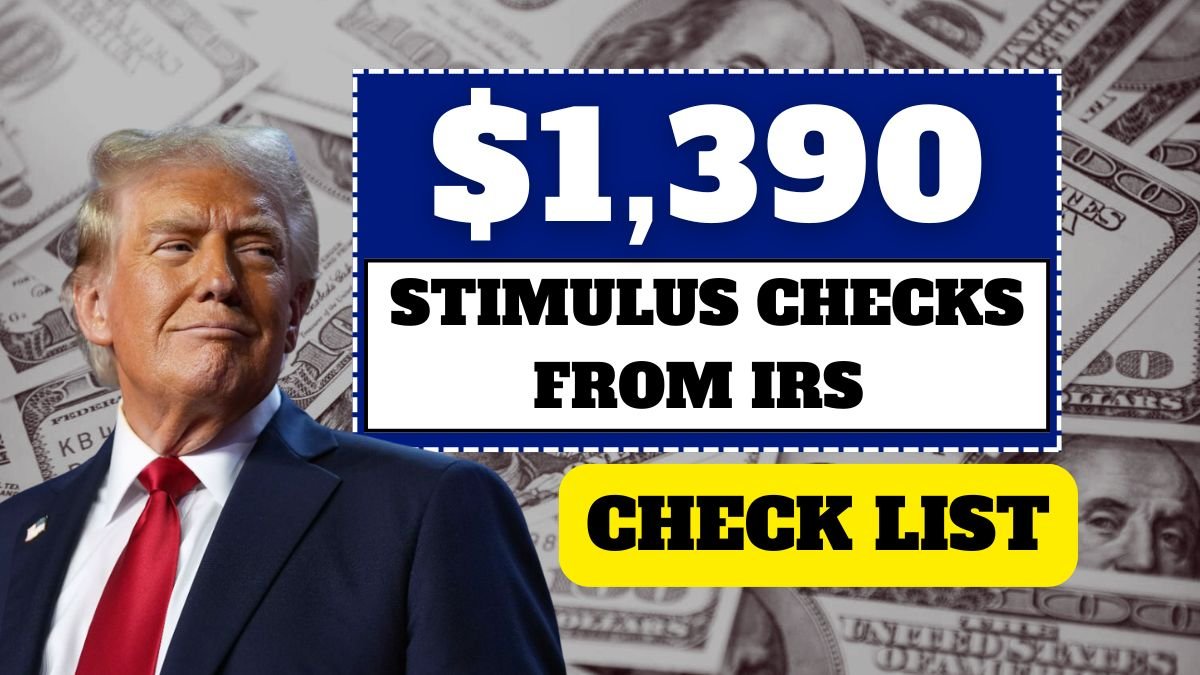This news is like a sigh of relief for millions of people living in America. A financial assistance amount of $1,390 is likely to be distributed under a new stimulus checks in the summer of 2025. This scheme is being specially designed keeping in mind those families and individuals who fall in the low- or middle-income group and who are struggling with inflation, rent, medical bills, food items and other essential expenses. The purpose of this relief scheme is to provide some relief to the economically weaker section so that they can meet their basic expenses.
This scheme will be operated by the Internal Revenue Service (IRS), and the payment process will be done through direct deposit, paper check or EIP debit card. Although the official date has not been announced by the government yet, according to experts and media reports, this distribution can start in mid-2025. It is being considered as a major initiative of the US government, which will directly help those families who are struggling with the economic crisis.
What is the main objective of this scheme?
This stimulus check can be very important for the people suffering from inflation. Economic instability has posed a new challenge in America since the pandemic. While the cost of food items, fuel, rent and health services is constantly increasing, the income of common citizens has not seen the same pace. This relief amount has been proposed to bridge this gap and help the common citizens.
The biggest thing is that this stimulus check will be tax-free. This means that the person receiving it will not have to include it in his income tax return. Additionally, this check will not affect your existing government assistance schemes such as Medicaid, SNAP (Food Stamps), or Housing Assistance. That is, it will be given as an additional amount, which will not affect any of your other assistance.
Who will be eligible for this $1,390 assistance?
Some clear eligibility conditions have been set to get assistance under this scheme. The most important thing is that this scheme is for those who fall in the low- or middle-income group. Apart from this, your tax status also plays an important role in this eligibility.
The main eligibility criteria are as follows:
- Single Filers: Those whose annual income is $75,000 or less.
- Married Filing Jointly: Those whose combined income is $150,000 or less.
- Head of Household: Those whose income is $112,500 or less.
Apart from this, you must be a US citizen and have a valid Social Security Number. It is also necessary that you have filed income tax returns for 2023 or 2024. If you have been claimed as a dependent on another person’s tax return, you will not be considered eligible under this scheme.
When and how will you get the payment?
The official date of stimulus payment under this relief scheme has not been announced yet, but according to IRS sources, it may start in the summer of 2025. The first phase will be paid to those whose bank account information is already available with the IRS. This method is called direct deposit and is the fastest method.
If your bank details are not available, you may receive payment through the following methods:
- Paper Check: It will be sent to your address through the mail. It may take a few weeks.
- EIP Debit Card: Some beneficiaries may also be given this amount in the form of a prepaid debit card so that they can use it at an ATM or POS.
You should ensure that your address and bank details are updated on your IRS Online Account. This will prevent payment delays and also reduce the chances of fraud.
How to avoid fraud?
As soon as the news of stimulus payment comes, fraud scammers also become active. They try to steal people’s personal details by giving false information through fake emails, text messages, and websites. Sometimes they claim you are eligible for a sum of $2,503 but ask for a “processing fee” or “personal details” in return.
Keep in mind: The IRS never asks you for your personal information via text or email.
Ways to avoid fraud:
- Always get information from government websites like irs.gov or treasury.gov.
- Do not click on any unknown links and do not give anyone your Social Security Number or bank account details.
- Forward suspicious emails or texts to the IRS at phishing@irs.gov.
- File a complaint using the IRS’s fraud reporting portal.
How will you get paid?
There will be three major modes of payment under this scheme:
- Direct Deposit: Those whose bank account information is already available with the IRS will be sent the amount first through this medium.
- Paper Check: Those who do not have bank details will be sent a check by mail.
- EIP debit card: Some beneficiaries will receive a prepaid card that they can use at ATMs or stores.
It’s important to log in to the IRS website to check that your information is up-to-date.
Conclusion: Vigilance and preparation will pay off.
Expectations are high for this potential relief amount of $1,390, especially among those who are struggling financially. But until there’s an official announcement about this plan, you should be wary of fake claims and scams.
Have the right documents ready at the right time, update your IRS profile, and get information only from official sources. If you meet all the conditions, it is completely possible to take advantage of this relief scheme, and it can bring a positive change to your financial situation.
FAQs
Q. Who is eligible for the $1,390 stimulus payment?
A. Single taxpayers earning up to $75,000, married couples earning up to $150,000, and heads of household earning up to $112,500 may qualify.
Q. When will the $1,390 stimulus checks be distributed?
A. The payments are expected to be sent out in mid-summer 2025, although an official date has not been confirmed by the IRS.
Q. How will I receive the stimulus payment?
A. Payments will be issued via direct deposit, paper check, or EIP debit card, depending on the recipient’s information on file with the IRS.
Q. Will the stimulus payment affect my other benefits?
A. No, the $1,390 payment is tax-free and will not impact benefits like SNAP, Medicaid, or housing assistance.
Q. How can I avoid stimulus-related scams?
A. Only rely on official IRS websites (irs.gov), and never provide personal information via text or email. The IRS does not request sensitive data through these channels.


